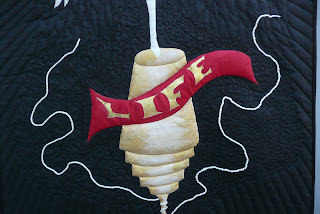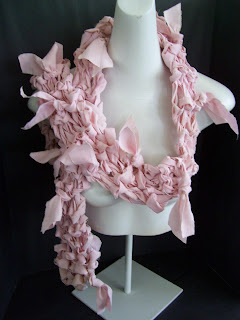I am very honored that my pink boa has been included in a pink themed Etsy Treasury, Many thanks to Ivona2.
A site dedicated to fiber arts, art quilts, soft sculpture, surface design, and optimizing techniques in other artistic media.
Thursday, July 26, 2012
My Pink Boa is Featured in an Etsy Treasury
I am very honored that my pink boa has been included in a pink themed Etsy Treasury, Many thanks to Ivona2.
Tuesday, July 24, 2012
"Black and White with a Twist of Color"
"Balancing Act"
 |
| 30"x54" Black and White Quilt with 10% Color |
This work began with a drawing and went through several transformations.
 |
| First Drawing |
 |
| Second Drawing |
The first drawings were rendered on 8 1/2" x 11" paper. The next steps were to print the final drawing on a poster setting, tape the multiple sheets together and then tape the entire unit to the cutting board work surface.
 |
| Enlarged Drawing |
After the drawing was secured to the drawing board, I laid white cotton fabric on top of it and taped down the edges. Next I traced the drawing onto the fabric with pencil. It is at times like these that I wish for a huge light box because seeing the lines through the fabric was challenging in some places where the lines on the paper were not dark. That's where imagination and artistic license were put to use.
 |
| Transferred Drawing with Beginning of Color Blocking |
I used Setacolor Transparency Black Lake applied to the edges of the figure with a rather small, stiff, rounded point, paint brush made specifically for fabric painting.
 |
| Continued Color Blocking |
Working close to the edges of the figure was a rather slow and meticulous process, but as I worked away from the edges of the figure, I was able to use a larger, flat brush to apply the color and this moved along a bit faster. After the entire background was blocked in with black, I began work on blocking in the banner and the image of a spinning top.
 |
| Blocking Color of Banner |
The three pictures that follow represent a very small quilt piece that I assembled and free motion stitched as I was auditioning how I might quilt the larger work. Since the figure was created directly with stitching and not a drawing, you will note that the figure is very cartoon like and, horror of horrors, it is missing a foot :-) This was okay, though. I merely needed some sort of shape around which I could experiment with quilting motifs. Ironically, I didn't use any of these with the final work but it was a good exercise to determine what I would NOT use.
Before I assembled a quilt sandwich I first baste stitched around the figure onto a layer of rather high loft batting, turned it over, and very close to the stitching line carefully cut away the high loft batting that extended beyond the figure.
After the entire background was quilted, the fun of embellishing began. I made a small quilt sandwich of white fabric and free motion stitched the shape of a feather and then cut close around the edges. This was sewn by hand to the quilt backing to imitate a falling feather.
At the tip of the spinning top shape I threaded a large eyed needle with string and sewed in and out and around the tip of the top. I made sure to leave a long tail on the string on both ends and then hand couched the string to the backing.
After binding the piece and affixing a label to the reverse side, the quilt was finished and I was happy.
 |
| Front of Quilting Trial |
 |
| Back of Quilting Trial |
 |
| Closeup of Quilting Trial |
Before I assembled a quilt sandwich I first baste stitched around the figure onto a layer of rather high loft batting, turned it over, and very close to the stitching line carefully cut away the high loft batting that extended beyond the figure.
Then I assembled a quilt sandwich comprised of the top layer, wool batting and backing fabric and used spray baste to secure all layers.
Stitching the Figure Outline and Wings
(Note: Later added beading to define
neckline and bodice and to intimate clothing)
Before I started quilting the background, I wanted to give the figure more personality, so I gave her a wild, raw edge appliqued headdress.
 |
| Raw Edge Appliqued Headdress |
Because I knew that close, heavy quilting might tend to distort the fabric, I first quilted around the figure with black thread and then set about quilting the wing feathers. At first I started to quilt each feather but didn't like how it flattened the feather shapes so I took the seam ripper to it and removed those threads. Unfortunately, this left needle hole markings. I overcame this by going back to each feather and stitching similar lines with no thread in the needle. Ultimately, I liked the texture that this gave the feather shapes.
After completing the quilting around each of the images, including the spinning top and the banner, I set about free motion quilting the background that surrounds the shapes.
 |
| Free Motion Quilting Around Figures |
 |
| Straight Line Quilting that Radiates from the Head of the Figure (Note: Lighting made this appear blue, but it is actually black) |
After the entire background was quilted, the fun of embellishing began. I made a small quilt sandwich of white fabric and free motion stitched the shape of a feather and then cut close around the edges. This was sewn by hand to the quilt backing to imitate a falling feather.
 |
| Falling Feather |
At the tip of the spinning top shape I threaded a large eyed needle with string and sewed in and out and around the tip of the top. I made sure to leave a long tail on the string on both ends and then hand couched the string to the backing.
 |
| String Hand Couched to Represent a Spinning Action |
As mentioned above, I defined the figure's neckline and bodice with an outline of beads. To me the massive black background might have been interpreted as an abyss and I didn't want that. I wanted to reflect hope and possibility--an elevation of life and an aiming for the stars while performing life's delicate "balancing act", so I punctuated the background with a diagonal swath of randomly placed glass beads to suggest stars.
 |
| Reaching for the Stars |
After binding the piece and affixing a label to the reverse side, the quilt was finished and I was happy.
So, all you quilt affionados, do visit the International Quilt Festival at the Long Beach Convention and Entertainment Center that starts this coming Friday evening, July 27th and runs through Sunday, July 29th. Be sure to stop by the Quilts on the Wall exhibit that features the works of 27 quilt artists from the Southern California area.
Saturday, July 21, 2012
"Through the Marsh at Dusk" - a Sharpie Pen Overprint
A few weeks ago I posted a Sharpie Pen with an alcohol spritz print. On that day I had actually made two different prints, but the second one seemed drab and I didn't believe it was worthy of posting. That print sat on my work table just looking at me and vexing my sensibilities. I even contemplated cutting it up or even throwing in away. Before taking either of these drastic steps, I decided to use it as a background and over print it. Unfortunately I didn't take a picture of the original print, probably because I didn't like it. Here is the final product with various over printings that will be explained below.
If you look closely, you will see shadows of orange, yellow and black circular images. That was the original Sharpie Pen print.
 |
| "Through the Marsh at Dusk" - A Completed Overprinting |
First I applied blue painter's tape to make parallel lines and then used a stencil brush to apply Setacolor transparent paint in one direction. Next the tape was applied perpendicularly across the first stenciled lines and also stenciled with Setacolor transparent paint. A grid was created that started to look a bit like plaid. I rather liked that but it probably would have made a better print for pajamas than a basis for an art work.
I dug into my stash of previously used screens and found these two that I thought might provide a counterbalance to the overall grid design.
The screen on the right produces an image that resembles grass or reeds and/or flames, depending upon the context in which it is used. In this instance it could be used as reeds. I did not screen it but, instead, used a stencil brush and a combination of red and green Setacolor transparency paints to make two, side by side, stenciled images.
After the reed layer was dry, I used the flying bird screen also as a stencil to apply three bird images with opaque, white Tulip fabric paint. At first I was distressed that all the images were not crisp but upon a second look, I believe that the inconsistent printing actually enhanced the feeling of movement as these birds fly through marshland reeds at dusk.
It took a bit of doing to make what at first seemed like it was a flopped experiment into something that just might have possibilities.
It's a good day when a questionable "orphan" piece is brought into the larger family of works in progress.
Subscribe to:
Comments (Atom)










